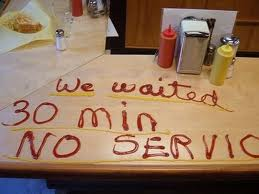Whose role is it anyway? The organisational side of Customer Experience
The philosophy behind customer experience has been around since cavemen first traded a club for a spear. It was simple then, as it is now. If you didn’t like who you were buying from or you felt they were getting more out of it than you, you’d probably get your own back by inventing the wheel or going to see who’s in the next valley.
Maybe because we’re better at evolution than revolution, many organisations today are shoe-horning that basic concept of customer experience into an existing model. And while there are companies who regularly get a mention for making us feel good about doing business with them, many more have reinvented that wheel only to have it spinning, making very slow – if any – progress.
There are generally three types of organisational approach to tackling customer experience; add the responsibility to an existing team, create a new team or have a culture where everybody is accountable. The benefits of customer experience are buried beneath a duvet of repeated platitudes so I won’t cover those here, but the unintended pitfalls of each are worth a quick look.
Add customer experience to an existing team
Done in the right way it can be highly motivating to be asked to take on more responsibility, especially if it’s to lead and manage something like the customer agenda. A bigger challenge but a bigger profile too. Usually, it will be complementary to the role that team already carries out – Marketing, Customer Service or Complaints for example.
But rarely will the existing responsibilities be pegged back and often the measures by which performance will be judged are an extension of what the objectives are already. The consequence is that while the ambition is there, the reality is that the day-job still takes priority. At best, the specific skills and way of thinking that are needed to run a customer experience programme evolve from what is there already. At worst, the team gets a pasting in their performance review because what the CEO expected isn’t delivered. Rather like their customers’ experiences.
Create a new customer experience team
Surely the watertight answer? Not always. For the individuals involved, being part of a new team is exciting in its own right. Being part of an organisation that is putting its money where its mouth is, even better. It’s a great opportunity and if – and that’s a big if – the top-level sponsorship is visible and solid, the opportunity to influence others to do the right thing is inspiring.
Yet teams can easily become a victim of their own success if they let it. The creation of a bespoke go-to resource that is going to lead the customer experience charge carries an inherent danger that others think they are absolved of the responsibility. That mind-set is exaggerated if performance measures across the organisation don’t change to be in sync either.
Without the right leadership and engagement of peers, the team quickly finds they are picking up everything and anything to do with “customer” on behalf of the business. They get to handle complaints, they run customer service weeks, they monitor and report on compliance outcomes and they get drawn in to police programmes and projects.
Individuals who are given the customer experience roles from other parts of the business often remain task-oriented, keen to impress and be busy. So will they have the inclination, confidence or authority to learn specific customer experience skills? To follow what is being said about them and their competitors in social media and to develop reciprocal relationships with internal and external partners based on mutual understandings? Or will they settle for linear process maps rather customer journeys? Report to their boss that the call-centre manager won’t carry out a quick survey at the end of calls because it adds to the average handling time metrics?
Strong governance, inclusive of every part of the business from reception desk to board table is the key. Working to the same priorities that everyone else is, knowing what the latest brand campaign is all about, understanding each other’s challenges – it’s nothing new but its effective adoption by many ranks naively low on the corporate ‘to-do’ list.
Have the right culture
The good news is that whether they know it or not, every organisation already has a customer culture. The bad news is that it’s not always the right one. Even worse, some are unable to articulate which it is, good or bad.
In the same way that we shouldn’t need complaints departments, a well-led customer experience department should do itself out of a job. It’s not a function, it’s a way of thinking and a strategic tool that makes the business more efficient; driving out duplicated and superfluous costs and focusing resources of the things that matter most to the health of the company and repeat business from more of the most valuable customers.
Delivering on the strategic plan, whether it’s to stabilise, grow or transform a business takes much more than a poster on the wall that proclaims “We put customers at the heart of everything we do!”.
What does the right customer culture look like? That is up to you, your brand and your leadership style. But as they say, what’s on the inside gets reflected on the outside.
If your people have little understanding of what the business is doing and why, if they are applauded for following processes rather than doing what’s right for the customer and if they talk about their competitors more than their own brand, then maybe the time is right to step outside.
Join the others looking in, see what they see and do something about it – before they head off to the next valley.














